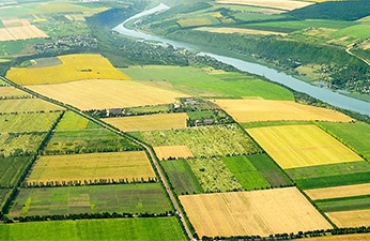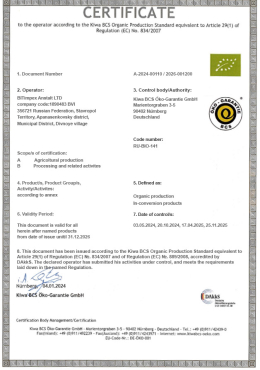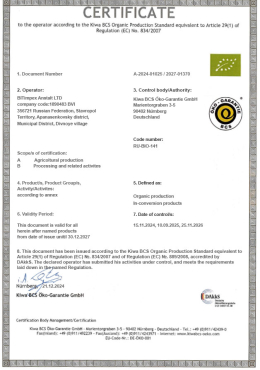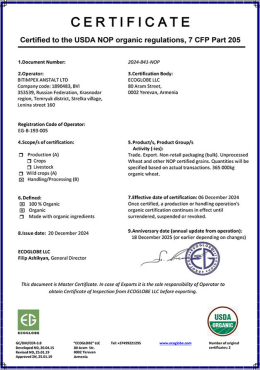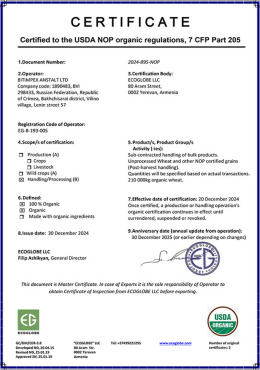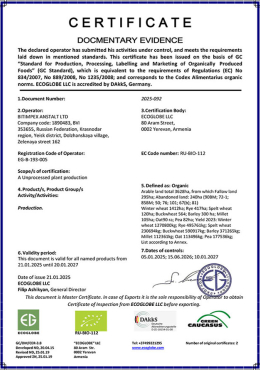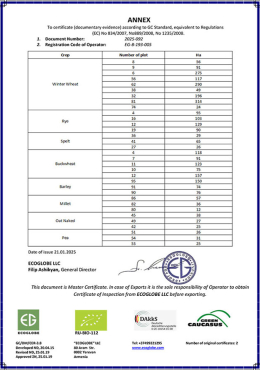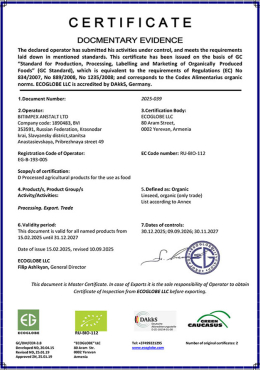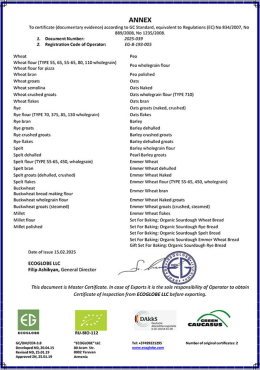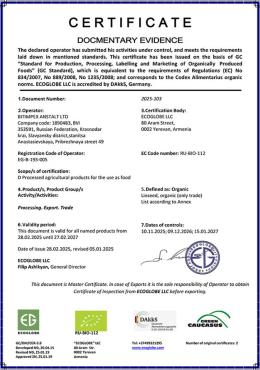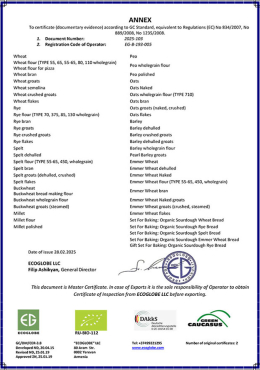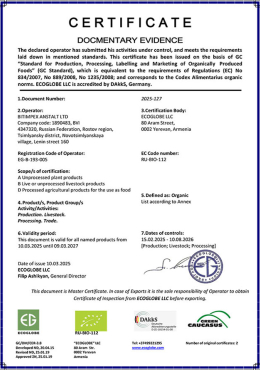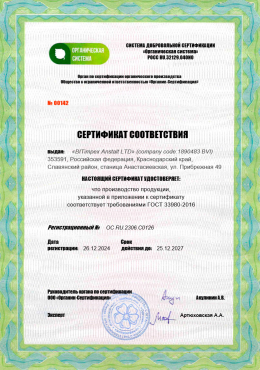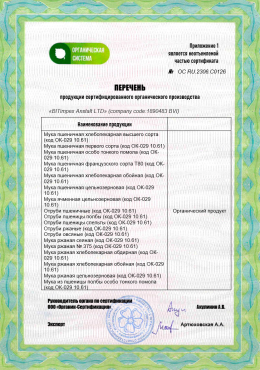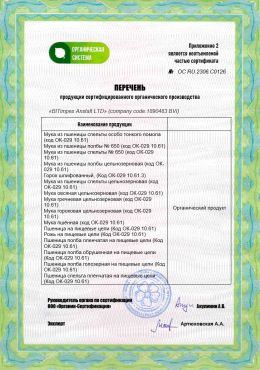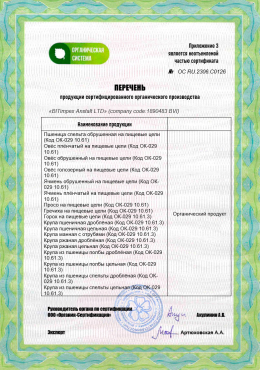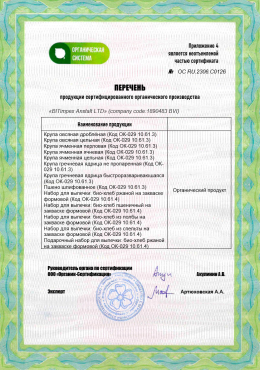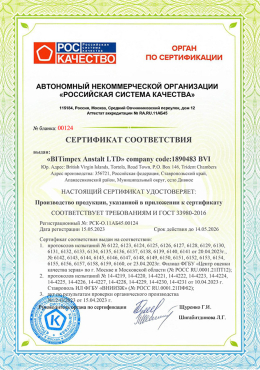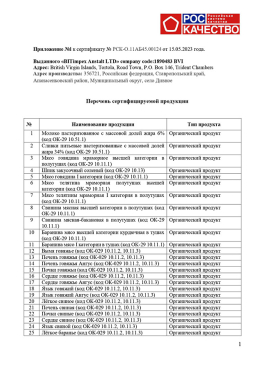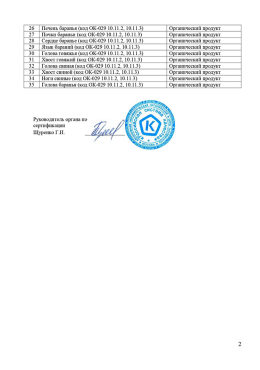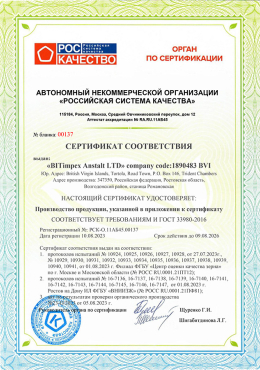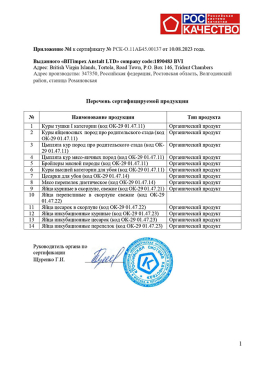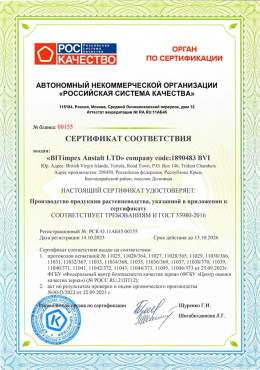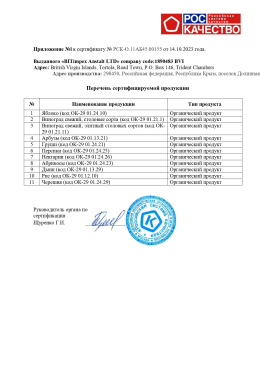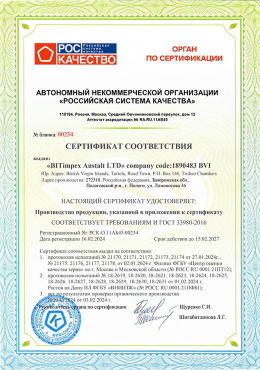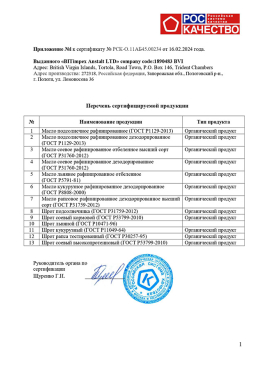Organic certification
- Agriculture
- Our Elevators
- Our Certificates
- Our Diplomas
- Organic certification
- European Certification
- Halal Certification
- Wheat - Wheat flour - Mills
- Buckwheat - Buckwheat flour
- Linen Seeds
- Corn – Сorn flour
- Oats – Oat flour
- Rye – Rye flour
- Barley – Barley flour
- Sunflower seed
- Chickpeas, Peas – Pea flour
- Beans
- Soybean seeds
- Pumpkin seeds
- Rape seeds
- Sugar beet pulp
- Beer pellets
- Meal for animal feed
- Production plant L-lysine, Gluten, Alcohol, DDGS, CO2
- Sugar Factory
- Oil Extraction Factory
- Rice Processing Plant
- Milk Powder Production Plant
- Meat Processing Plants
- Fruit Storages
- Bioproducts Plant
- Malt plant
- Cheese production plant
- Aquaculture feed production plant
- Cold Storage and Meat Processing Plants
- Cattle - meat beef
- Pig breed - Pork meat
- Sheep breeds - lamb meat
- Poultry meat
- Chicken egg
- Quail
- African chicken, cisar hen
- Geese meat
- Our beegarden
- Honey
- Bee products
- Gardens
- Containers, packaging and calibration
- Factory for the production of juices and tomato paste.
- Quince
- Pear
- Peaches
- Plum
- Cherry
- Apples
- Apricot
- Berries
- Grape
- Figs
- Mulberry
- Nuts
- Almond
- Watermelon cultivation technology
- Melons
- Transportation
Organic certification
Organic standards may apply to agricultural products. In this case, all grown crops are actually more expensive to sell, and the quality of such products is confirmed by a certificate during inspections.
Goals of implementing organic farming standards:
eliminate the use of various synthetic fertilizers and pesticidesAndimprove health agro-system as a whole, which will also make it possible to grow products that are more resistant to external adverse factors. Take into account the biological characteristics of the soil, including biological cycles, prevent the destruction of the fertile layer through the use of new standards for tillage, that is, the preservation of humus. Compliance with organic standards allows you to enter the markets of other countries and export goods to those countries where there is strict regulation and huge demand for organic products.
Requirements for organic production systems.
Farms and enterprises growing products that will meet the organic standard must comply with the following operating principles:
- Use only clean water, preferably artesian water, and safe technologies, adhere to the rules of renewable resources.
- The use of any pesticides, antibiotics, hormonal drugs and drugs that artificially accelerate or stimulate plant growth is prohibited.
- Actions aimed at influencing the plant genome, non-natural interference, and the use of GMO technologies and products are prohibited.
- The use of ionizing radiation is prohibited.
- The use of nanomaterials and nanoparticles is not allowed, including when packaging products.
When switching to organic farming, products grown according to organic production standards must be separated from conventional ones. Packaging and storage - everything must be separate. If a farm has ORGANIC status, then it is under constant control of the certification body. There is continuous communication and interaction. ORGANIC status is confirmed every year. The work of the certification body is also paid annually. Certification costs amount to several tens of thousands of rubles according to the Russian standard GOST 33980-2016.
It is necessary that the enterprise staff has a person responsible for communication with certification bodies. The transition to organic agriculture is voluntary. From the moment of transition to organic agriculture, certification is mandatory. Certification is carried out by independent certification bodies accredited by Russian Accreditation in accordance with GOST 33980-2016, or by international certification bodies accredited to the standard we require.
A certificate is a legal confirmation that the product was manufactured in strict compliance with the standard to which we have been certified. The certificate creates trust between the buyer and the manufacturer.
What does the certification body check?:
- Agricultural land and its surroundings (if necessary, do soil tests).
- Planting material, hybrid seeds.
- Place for keeping and grazing livestock and birds.
- Food supply.
- Agrotechnological maps.
- Process operations plan.
- All plant protection and nutrition products (veterinary preparations, feed and feed additives that will be used).
- Accounting. What exactly was purchased, how many products were sold. Warehouse, equipment, agricultural machinery, washing and disinfection products.
Packaging and processing so that products are not mixed with regular ones.
- The amount of harvested crops and products produced. The amount of harvest must match the organic area so that it does not pass off as organic products from conventional fields.
- Also transportation. A transaction certificate is issued according to international standards. Full traceability of cargo movement. Photos during inspection are attached.
- Staff are surveyed, if any of the employees are not committed to organic agriculture and express doubts, this is noted. In this case, the farm inspection is carried out with greater care. Employees of neighboring farms may also be interviewed about their neighbors’ environmental management.
The certification scheme for organic production is as follows::
- Evaluation of test documentation, i.e. type tests.
- Production assessment, analysis of production status.
- Inspection control.
- Testing samples taken from the seller.
- Analysis of the state of production at this stage.
- Certification.
- Second type test.
- Analysis of the state of production.
- Testing samples taken from the manufacturer.
Type testing is an assessment of one of the independent product samples that are its typical representative.
Proper care when practicing organic farming is not only the right soil and seeds. This also means caring for them and cultivation techniques. We extracted this knowledge from nature.
For example, we consciously abandoned deep plowing in order to allow numerous living organisms (earthworms, insects, bacteria and larvae) to do their work, contributing to the formation of a fertile layer of soil. We create natural conditions for plant growth, without chemicals or synthetic fertilizers. To maintain fertility, it mainly uses crop rotation. There will be crop rotation and there will be a harvest. Active plowing and mulching, manual work and mechanical weeding. These are methods that allow plants to maintain natural immunity to pests and diseases in their natural environment. All this, plus the absence of negative factors such as the proximity of large cities, highways, and enterprises, creates an extremely favorable environment for obtaining a decent harvest even in bad years. But all our gardens, all our small grape plantations in Crimea are located
in mountain and foothill regions. Some farms are even located several kilometers from populated areas.
We will focus on some of the standards in European Bio Certification.
The use of chemical pesticides, genetically modified crops and synthetic fertilizers is prohibited in crop production. For at least three to four years, the land must be free of any additives not permitted for use in organic farming. Only then can it be considered organic. After appropriate checks and studies, the purity of the land is confirmed by regular laboratory tests. The use of organic fertilizers, even of animal origin, such as manure, dry manure, dry droppings, animal compost and the like. Suitable microorganism formulations can be used to improve the general condition of the soil.
Manual labor.
80% of the workers of our holding Bitimpex Anstalt, in our gardens, orchards, and vineyards, do manual labor. This means caring for plants, harvesting and processing crops - everything is done by hand. Planting of plants is all done by hand. We use technology only for sowing certain types of seeds in the soil and digging them up (for example, such as potatoes).
The quality certificate not only proves the complete absence of pesticides, antibiotics, hormones or other chemicals in products of both animal origin and crop production, but also shows our careful attitude to farming in all areas.
The main thing is to take care of the ecosystem as a whole, throughout all cycles and systems in production.
Russian Standard GOST 33980-2016 with the ORGANIK sign.
In Russia, only this labeling gives the right to officially call products organic. The Bitimpex Anstalt holding is included in the register of organic producers and has a certificate from the Russian quality certification body.
Principles of organic agriculture. The standards were developed in 1980 by the International Federation of Organic Agricultural Movements (IFOAM). The main principles are health, ecology, justice and care for people.
Ecology
Organic farming follows natural cycles and maintains ecological balance. Producers must preserve the environment and reduce any negative impacts on the ecosystem.
Organic farming protects the health of current and future generations and the well-being of the environment.
Bitimpex Anstalt approaches the choice of technologies and management methods with responsibility and caution so as not to cause harm. It is most important.
We have already previously spoken about the criteria for Bio certification, but we can go into even more detail.
Ingredients
95% of product ingredients must meet organic standards. The remaining five must be natural and approved for use by EU regulations.
Earth
For at least three or four years, land devoted to the cultivation of organic crops must be free from traces of chemical fertilizers, from traces of cultivation, from any pesticides, and from any additives not permitted for use in organic farming. The cleanliness of the land is confirmed by regular laboratory tests carried out by relevant laboratories.
Livestock
All animals must not only be kept tethered, but also kept freely and roamed freely. To prevent diseases, the most comfortable conditions are created, suitable for each type of animal.
The use of tranquilizer hormones and prophylactic antibiotics is prohibited. When treating, preference is given to phytotherapeutic drugs and homeopathic drugs.
The main diet of animals on our farms is high-quality organic food made in-house. Our zootechnologies formulate the feeding diet of animals, taking into account their biological characteristics. Our green food is grown in our organic fields, on our own plots. Every day we bring fresh green mass from the fields, mix it with feed, which is produced in our mini-feed complexes, place the feed in feed mixers, for each group of animals separately, and then deliver the finished feed to the buildings.
Some animals and birds are free-range on the vast pastures of our holding.
We also built our own feed production workshop to fully control the quality of animal nutrition. For the production of feed, organic raw materials were additionally ordered from trusted suppliers from different regions of both Russia and abroad. Such nutrition allows us to be confident in the excellent condition of all our animals: cattle, sheep, pigs, guinea fowl, chickens and quails. And accordingly, in the excellent quality of our products.
Own Laboratories
All our organic workshops are certified according to the HACCP system and have their own modern laboratory. There, each batch of products is tested to ensure compliance with the highest quality standards. In addition, we produce our own product components in our laboratories. For example, we grow green food ourselves in order to fully control the quality of animal nutrition, and we produce compound feed ourselves. A healthy diet allows you to be confident in the excellent health of animals and the excellent quality of products, especially for organic products. On January 1, 2020, Law F3 dated August 3, 2018 No. 280-F3, on organic products, and on amendments to certain legislative acts of the Russian Federation regulating the production of organic products came into force.
In December 2021, the Bitimpex Anstalt holding confirmed the compliance of production with the requirements of state standard 33980-2016, organic products, rules of production, processing, labeling and sales, and entered the unified state register of producers of organic products.
Ecological euro production is the policy of the founders of our production and agro-industrial holding Bitimpex Anstalt. We initially decided to grow and process environmentally friendly grain and grain products, horticultural crops, grapes,livestock and poultry products. We did not have a transition period; from the moment the company was founded, we began to sow organic products on uncertified fields.
The company is annually certified for compliance with environmental standards. All our products, I repeat, have an organic certificate. We want to become better and better every day, for this we are constantly learning. We want to make our products accessible to all our customers.
Eco Bio Organic- what it is? Compliance of product production with the requirements of GOST 33980–2016.
Advantages of this certificate.
The standard was developed in accordance with the recommendations of the Codex Alimentarius CAC/GL 32-1999, guidelines for the production, processing, labeling and marketing of organic food products. And harmonized with the European Union organic regulations number 834/2007 and 889/2008, IFOAM basic standards.
This is the only standard that allows the legal use of organic product labeling on the territory of the Russian Federation, as well as in foreign countries where the Russian Federation has agreements to recognize our environmental standards.
Soils of Crimea
We will make a short review of soils in Crimea. Why Crimea? This is a risky farming area. Let's start with the Nakhimovsky district, where we have vineyards and orchards. The total area of vineyards in the Nakhimovsky district is somewhere around 300 hectares.
The soils are represented by chernozem, foothill carbonates,plantedlands. On slopes in soils formedPliocenesediments. The content of stones and gravel in the soil is from 1% to 15%. On the plateau, as a rule, the parent rock 50-60 cm is represented by weakly or strongly gravellyGalichnikovdeposits that have a heavysublimated granulometric soil composition. The reaction of the soil solution is alkaline, the pH is approximately 7.5 to 8.5. The supply of soil with humus varies from low to high. The soils are not salinized with toxic salts, this is important. The active lime content ranges from 3% to 25%. The slopes and lower parts of the ravines are characterized by richer fertile soils, while areas on the plateau have a low level of fertility. Often the surface of vineyard soils is completely covered with pebbles, which increases the heat capacity of the soil. During the daytime, the stones heat up and give off heat to the vineyards; even after sunset, this heat is retained, which provides the middle and late varieties with optimal ripening in case of changing climatic conditions. At the same time, the high content of active lime in the soil preserves rich aromatics and lively acidity in the vine. The harvest is always harvested only by hand due to the fact that we mainly have only table grape varieties. This requires you to be very, very careful in the process of harvesting these grapes, and to care for them accordingly. The planting density is about 5,200 vines per hectare. Rocky and calcareous soils and well-ventilated plantings make it possible to obtain grapes with good ripeness.
The average annual temperature in this region and territory is about + 12°. The annual amount of precipitation in the area of the analyzed areas is about 500 mm, including 150-160 mm in winter, 120-130 mm in spring, 100 mm in autumn. During the period of active grape growing season, 250-270 mm falls during the active growing season, and 240 mm during the dormant period. The relative air humidity in the vicinity of the analyzed areas on average for the year is 73 - 75%; in July August the humidity drops to 65%. The duration of the active growing season is 170 - 175 days. The length of the growing season and its heat supply allow grape varieties to be grown here from very early to medium, and in some parts of the site with a southern exposure of the slope, to medium to late ripening.
Our next vineyards and gardens are located in a picturesque place, in the valley of the Bakhchisarai region. These gardens and vineyards are surrounded on all sides by hills, with a green carpet of colors and flowers.
In order to move forward, we sometimes have to take a few steps back, observing and listening to nature, waiting for an answer. Using no chemical fertilizers, no herbicides, no pesticides. Only elements of natural, organic origin. Believe me, this is very, very difficult.
We are sure that without care, without respect for the earth itself, there cannot be products that convey the signs of nature.
in 22, we received certificates of compliance with Russian organic GOST 33980-2016
In Bakhchisarai and Nakhimov districts We grow our crops in picturesque places. These places are among the best for growing grapes and horticultural crops in the region. The Alma, Kacha, Belbek rivers flow through. Alminskaya, Kachinskaya, Belbekskaya Valley is the Crimean Klondike.
The soil in the Bakhchisarai region is very, very interesting.
The content of active lime in the soil is from 6.8% to 19%, the pH value in the soil is from 8% to 9%, the content of stones and gravel in the soil is from 1% to 15%. The soil-forming nature consists of weathered loamy sediments with eluvium of shale and sandstone. The soil is brown, mountain-carbonate, slightly eroded and planted. The granulometric composition of the soil is from light loamy to heavy loamy, the content of active lime is high up to 19%. The soil reaction is weak to medium alkaline. There is no salinity observed in the soil. The soils have an average or low level of fertility, which allows for balanced harvests and does not lead to fattening of the vines and orchards. The increased lime content makes it possible to obtain grapes with very good performance. The total vineyard area in the Bakhchisarai region is about 370 hectares. The harvest in both gardens and vineyards is collected only by hand.
In the Bakhchisarai region, we planted vineyards according to the Burgundy scheme - planting with a density of 10,500 vines per hectare. The vineyard was planted in 2020. Grapes are still available in small quantities.
Such a high density of planting of grapes leads to strong competition between the bushes for living space, nutrients, water, access to sunlight, and other resources and allows you to get that very dense and compact bunch.
Today we have about 100 hectares of fruit-bearing, good, table grapes. Let's not dwell on varieties, this will take a very long time.
In 2022, another 600 hectares were planted in the Bakhchisarai region. This time we made the planting density less - 5100 vines per hectare.
The average annual temperature in the Bakhchisarai region, in the area of our vineyard gardens, is +11.5°. The average monthly air temperature throughout the year is above zero.
The coldest temperatures in our areas occur in January and February. During these months, the temperature can reach up to +2°, and in the warmest months of July and August, the average air temperature in the foothill regions is 23° - 24°. The ideal rainfall for the growth of vines and gardens averages 520 - 530 mm per year. Moderate southeasterly winds prevail throughout the year. The relative air humidity in the vicinity of the analyzed areas on average per year ranges from 75% to 77%.
Spring frosts do not limit the duration of the growing season of grapes and horticultural crops. The duration of the active growing season of grapes is not reduced, so we selected table grape varieties with early and medium ripening for planting, without delaying until later ripening.
Analysis of climatic conditions allowed us to select the optimal varieties for gardens and vineyards. The mild, not excessively hot climate makes it possible to place a group of Burgundy grape varieties here. It is possible to avoid overripening of both grapes and garden crops.
The soil relief is a slightly hilly plain with a slope of 4° - 8°. The location of the vineyards on the slopes of mountains and hills allows us to obtain high quality grapes.
The ancient Roman poet Virgil wrote: “Bacchus loves the hills.”
At the same time, the low slope of the hills and effective and modern agricultural practices make it possible to successfully avoid soil erosion. Taking care of the soil is our basic principle.
The exposition of the site is predominantly south-eastern, which is optimal for organic farming, since the south-eastern hills are the first to meet the morning sun. This contributes to their rapid drying from night dew, which naturally affects the reduction of the infectious background and the phytosanitary stability of both orchards and vineyards. The territory of the plots belongs to the western foothill Heracles agroclimatic region.
In the Nizhnegorsky region we also have vineyards and garden plantations. They are located in a fertile, fertile area.
These areas are surrounded by meadows, arable land, and hilly terrain. a favorable place for growing garden crops and vineyards. Geographically, they are located in the northeast of the Crimean Peninsula.
The history of our development of this area began in the fall of 2005, when it was decided to establish vineyards and garden plantations. This period became a starting point for us. And in the development of horticulture and viticulture. The plots in the Nizhnegorsky region are an ideal place for growing both vineyards and garden plantations. Thanks to the climatic conditions of Crimea, sunny summer days and warm autumn periods create an optimal ripening regime for both fruit and berry garden crops and grapevines. Thanks to its proximity to the sea, the air has marine notes that give a special aroma to everything growing on these lands. The parent soil rocks in these areas are loamy formations, which are represented by loams and clays, they contain carbonates. Two soil types have been identified at the sites:
- Meadow - chestnut, carbonate, planted, light clayey, on forest-like clays. This is somewhere around 155 hectares. The thickness of the humus horizon is 45-55 cm.
- Lugovo is chestnut, planted, deeply saline, light clayey on loess-like clays. This is about 170 - 180 hectares. The thickness of the humus horizon is 50 cm.
The total area of our organic soils in the Nizhnegorsky region is somewhere between 520 and 530 hectares. All harvesting is done only by hand. The grape planting density was within 3850 vines per hectare.
Formation methodvines two-standard horizontal cordon. The varieties are also table varieties. Bushes formed as a two-stem horizontal cordon, with a stem height of 70 - 85 cm.
The climate in this region is close to the continental steppe, characterized by warm and hot summers, cool winters with short snow cover. Precipitation ranges from 250 to 400 mm per year. On average 280 - 300 mm and the main part of the fall occurs in June-July, and in the autumn-winter period. The average annual temperature is +11.5°. Throughout the year the prevailing winds are south-easterly. Relative humidity 62% - 65%.
Relief
The sites are located in the steppe zone of Crimea and are geomorphologically confined toTo the Prisivashskaya accumulative lowland, the relief is an undulating plain with hills; groundwater lies at a depth of 7–8 m. And it influences the soil-forming process.
In the western part of Crimea in the Saks, Evpatoria, and Black Sea regions, chestnut soils predominate. Dark chestnut loams occupy wide valleys and slopes, while light chestnut loams are more often found on steep slopes of ravines and in lower places.
Chernozem soils are located over a relatively large area. Smaller canvas chernozems are located closer to the foothills, while heavier ones occupy the plain. As you approach Prisivash, you encounter saline soils and solonchaks. Chestnut soils in the western part of Crimea were formed on limestone, and chernozem soils were formed on thick layers of clay.
Precipitation in this region is relatively low with 60% falling in the autumn-winter period and 40% in the spring-summer period. Air humidity is quite favorable for the ripening of garden crops and grapes.
Due to the dramatic influence of the proximity of the sea on the climate, this part of the area should be designated as an independent grape and garden region. Thanks to the rich soils and warm climate, with moderate humidity, high-quality table grape varieties and very good varieties of garden crops are produced here. Particularly valuable soils for these crops are carbonate soils on the slopes of the Sivash region valleys.
On the slopes of ravines, heavily crushed soils predominate; in low areas there are light chestnut soils with a high content of clay particles and sand. In general, the soils of this area are light and contain sufficient nutrients. Closer to the sea, in sheltered places, red and brown loams are found.
The soils of this area are richer, which makes it possible to obtain high yields.
Soils of the Krasnogvardeysky district. About 240,000 hectares are occupied by carbonate chernozems in the west and south of the plains. They are located in Tarkhankut and the northeast of the Kerch Peninsula.
There are three types of foothill chernozems:
- Leached
- Carbonate
- Solonetzic.
They occupy a total of 242,000 hectares.
230,000 ha occupy pure chestnut and dark chestnut soils.
Approximately 150,000 hectares are occupied by the sod-humus zone.
In Crimea, there are three regions where the soil is the most fertile: these are the Bakhchisarai district, the Nizhnegorsky district and the Krasnogvardeisky district.
Chernozems have a black or black-brown humus horizon. The layer absorbs water well, unlike peat. The main thing, unlike other types of soil, is its rich black color; deviation is possible only if the composition contains a lot of iron or manganese oxide. In this case, the color becomes slightly brown. Iron gives the soil an orange tint. Whitish inclusions indicate impurities of gypsum viburnum or calcium. In addition to humus, chernozem also contains calcium - about 70%. Humic acids no more than 15%. Magnesium at least 20%. Nitrogen, phosphorus and other impurities in smaller quantities.
The climate of the Krasnogvardeisky district is classified as the second steppe agroclimatic region, which is characterized by unstable winters with considerable temperature fluctuations. Thus, winter in the Krasnogvardeisky region is mild; the winter period itself lasts a little less than two months. summer is characterized by low relative humidity, up to 39% - 40%. Dry air combined with high summer temperatures causes significant evaporation from the soil surface.
The chemical properties of the soil in the Krasnogvardeisky district are characterized by acid-base absorption (neutrality indicator)
Acidity: 1 pH - 6 pH;
Alkalinity: 7 pH - 9 pH;
Absorbability (indicator of neutrality): 6 pH - 7 pH.
The ideal value for garden soil is between 1 pH and 8 pH.
Increased acidity is normalized by lime, and increased alkaline composition is normalized by sulfates. Aluminum predominates in clay soils, silicon predominates in sandy soils, and calcium predominates in calcareous soils.
The most important property of the soil in the Krasnogvardeisky region is its fertility. This ensures the development and growth of plants, gardens, vineyards, and is also a home for bacteria and microorganisms. The value of the land located in the Krasnogvardeysky district, the fertility of the soil not only lies in its importance for agriculture, but also the most important component of the earth’s biosphere. The soil cover provides the ecological connection of all living organisms with the lithosphere, hydrosphere and atmosphere of the planet.
From fertile soil, all living plants receive a set of nutrients: oxygen, water.
Natural fertility comes from the humus layer of the earth, which contains calcium, phosphorus, nitrogen, iron and many other elements necessary for plants.


